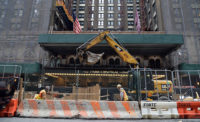New York City Construction Sites, Now Open, Adjust to New Realities

The day New York City enters Phase 1 of reopening after shutdowns caused by the COVID-19 pandemic, Mayor Bill de Blasio speaks at a press conference at the Brooklyn Navy Yards. PHOTO BY GABRIELE HOLTERMANN/SIPA USA (SIPA VIA AP IMAGES)
With the June 8 reopening of all non-essential construction sites after nearly three months, New York City industry participants are treading carefully to regain lost time and build productivity amid new COVID-19 social distancing and other safety rules.
The city is the last region in the state to open all construction sites officially, although work has been ongoing in many non-essential locations since the late March shutdown, industry sources confirm.
With city virus metrics improving, allowing all construction sites to reopen meets Phase 1 of Gov. Andrew Cuomo’s plan to revive the state economy. Regions must successfully complete this phase before other businesses can open, with new rules for all workers to prevent spread of the novel coronavirus.
Construction in other state regions opened last month.
Protests in the city related to the killing of George Floyd in Minneapolis did not delay the reopening; a city-imposed curfew of 8 p.m. ended on June 7, a day earlier than planned. There was no significant damage to construction sites, although plywood boarding and other protections for retail locations remain in place in numerous areas of Manhattan and other boroughs.
Spencer Levine, president of RAL Development, notes that one of its projects in Manhattan's Union Square was “in the center of the ongoing demonstrations.” He says the firm's safety and facilities manager was in constant communication with its third-party security contractor to monitor and secure the site.
While the firm was “concerned about the concentration of pedestrians gathering in the area around the site, as long as these demonstrations remained peaceful and non-violent, we applaud the exercise of the right for peaceful demonstrations and change,” Levine adds.
Common Sense
“In general, [construction industry] firms are looking for slow openings or a gradual return to work to support positive re-entry,” says Bill Edwards, an associate principal at engineering firm Thornton Tomasetti. “In volatile times, personal awareness and good decisions are a must when it comes to personal safety. I see a lot of businesses using good common sense to support this return.”
As of June 8, 33,556 previously closed non-essential sites were allowed to resume construction activity as part of the Phase 1 reopening, according to the New York City Dept. of Buildings. That is in addition to 8,243 essential construction sites that remained open during the shutdown, the department says.
The Building and Construction Trades Council of Greater New York, Building Trades Employers’ Association and Real Estate Board of New York announced on June 8 a "remobilization plan" linked to state and city edicts that set health and safety protocols for construction worksites during the pandemic. Protocols include requirements for personal protective equipment, social distancing, health screenings, increased washing stations, frequent cleaning and disinfection. They also call for face coverings "to be worn at all times on union construction sites."
Additionally, New York City Mayor Bill de Blasio signed an executive order requiring that employees and visitors to construction sites wear face coverings at all times.
The new trade group protocols also point to "creative measures" to reduce worker density on sites, including staggered start times, shift work and other alternative work schedules, which could involve 10-hour, 4-day weeks that the groups say "will require the cooperation of the City of New York."
The industry groups say they have formed an oversight committee "that will closely monitor on-the-ground activity" and "review any submissions by construction managers," related to compliance issues.
The city will need to grant variances for different work hours, and the agreement also stipulates a 5% wage-benefit premium for workers who take on second or third shifts, according to a June 7 report by real estate online trade publication The Real Deal.
"The safety of our members, and of all construction workers, must be the priority of any plan that remobilizes the construction industry,” said Gary LaBarbera, building trades council president, in a statement.
Lessons Learned, But Still Uncertainties
According to one city-based project executive with several projects of more than 1 million sq ft deemed essential, “working to some degree this entire time ... gave us the opportunity to try out different protocols and products before our sites were back to full strength, so that was helpful.”
The manager said some union trades "refused to return to work at first. They are back on site as of this week. Most of our sites were at 50-60% workforce [on June 8] and are targeting 80-90% workforce by next week.”
The executive notes that the firm “learned that we didn’t like the way UV-C lighting was used to disinfect our shanties, but we did like the way it worked within our HVAC system.”
According to the manager, “social distancing isn’t really a problem as most workers are willing to comply. The toughest issue we have had has been implementing and documenting the daily health screening."
Workers "do not want to pass around a paper and pen" to answer CDC health screening questions, the executive notes, with 14-day required paperwork storage “onerous” on large sites, some with “800+” workers. The firm is pursuing use of apps for digital storage. “There will be a learning curve when this goes into effect next week,” says the project executive.
For one open shop CM working on mid-size and smaller projects, “all of our jobs were at least partially open before June 8,” says the firm's CEO, adding that there are “operational protocols that prevent running the site at full capacity.” He notes staggered start and stop times for different trades and limited occupancy due to social distancing, including hoist limits of four persons. He characterizes productivity at 80%.
Productivity Issues?
"On average we 10%-15% productivity loss for the next few weeks. This will evolve based on how well the overall industry does with maintaining protocols, and continued loosening of restrictions if there are fewer outbreaks detected in the NYC area," says James Donaghy, chairman of STO Building Group. "The productivity impact is different from site to site, driven mostly by vertical/horizontal transportation delays and remobilizations." He says "only a handful of our sites remain closed, by client directive, in NY."
There are more than 100,000 unionized construction workers in New York City, the trade organizations say. But it was unclear how many would be returning to work in the city. The state Dept. of Labor notes that for April, the most recent month for which statistics are available, the overall unemployment rate was 14.6%, compared to the 3.7% rate in April 2019.
While the Dept. of Buildings doesn’t track the city’s specific employment numbers in construction, “at a minimum we expect tens of thousands of construction workers to return to work,” DOB press secretary Andrew Rudansky says.
Social distance rules still are areas of confusion, however.
The mayor's office directive doesn’t specifically address face-mask removal in lunch areas or for hydration "especially as the temperature goes up," STO's Donaghy says, which leaves uncertainty as to whether workers must leave a site to remove masks or can do so in specified areas with 6-ft distance maintained. "GCs who require workers to leave and return the site for lunch or to hydrate will potentially cause more exposure that could also cause issues with productivity," he contends. "These mandates have proven to be fluid, so as more feedback is provided the rules will evolve."
Productivity loss from density/social-distance rules and need for added site transportation for workers and materials will be "neutral within several weeks, once workforce behavior acclimates, lessons are learned, and supervision is fully deployed," says Donaghy. "Once enhanced and universal protocols are adopted by the industry at large, pricing in unknowns and lost efficiency will no longer occur, and schedule impact will be minimum."
With so many sites and employees getting back to work, the city’s late arrival into Phase 1 may have a silver lining: the ability to learn from other regions in New York state that moved to Phase 2.
'Normalizing'
“The essential sites that opened before today did help to normalize the new protocols,” says Marguerite Pinto, another Thornton Tomasetti associate principal. She notes all that sites she’s visited require masks and have supplies of them on hand, that there is enforced 6-ft spacing between workers “wherever practicable,” and circulating site safety monitors warning people if they’re too close.
“We will have to see how it works as it expands to all sites,” Pinto says of the protocols.
RAL Development's Levine says some firm’s projects, such as the Zero Irving tech hub, were considered essential and remained open, so it could learn first hand how to proceed with non-essential sites once those reopened. He says the company brought “project medics on all of our projects earlier than planned” to implement daily health questionnaires and temperature-taking.
“As we restart the economic engine that is our construction industry, there is no excuse to abandon the social distancing and health measures that we know save lives,” City Buildings Commissioner Melanie E. La Rocca says, adding that the department “will be out in force, sweeping every work site in the city, to ensure compliance."






